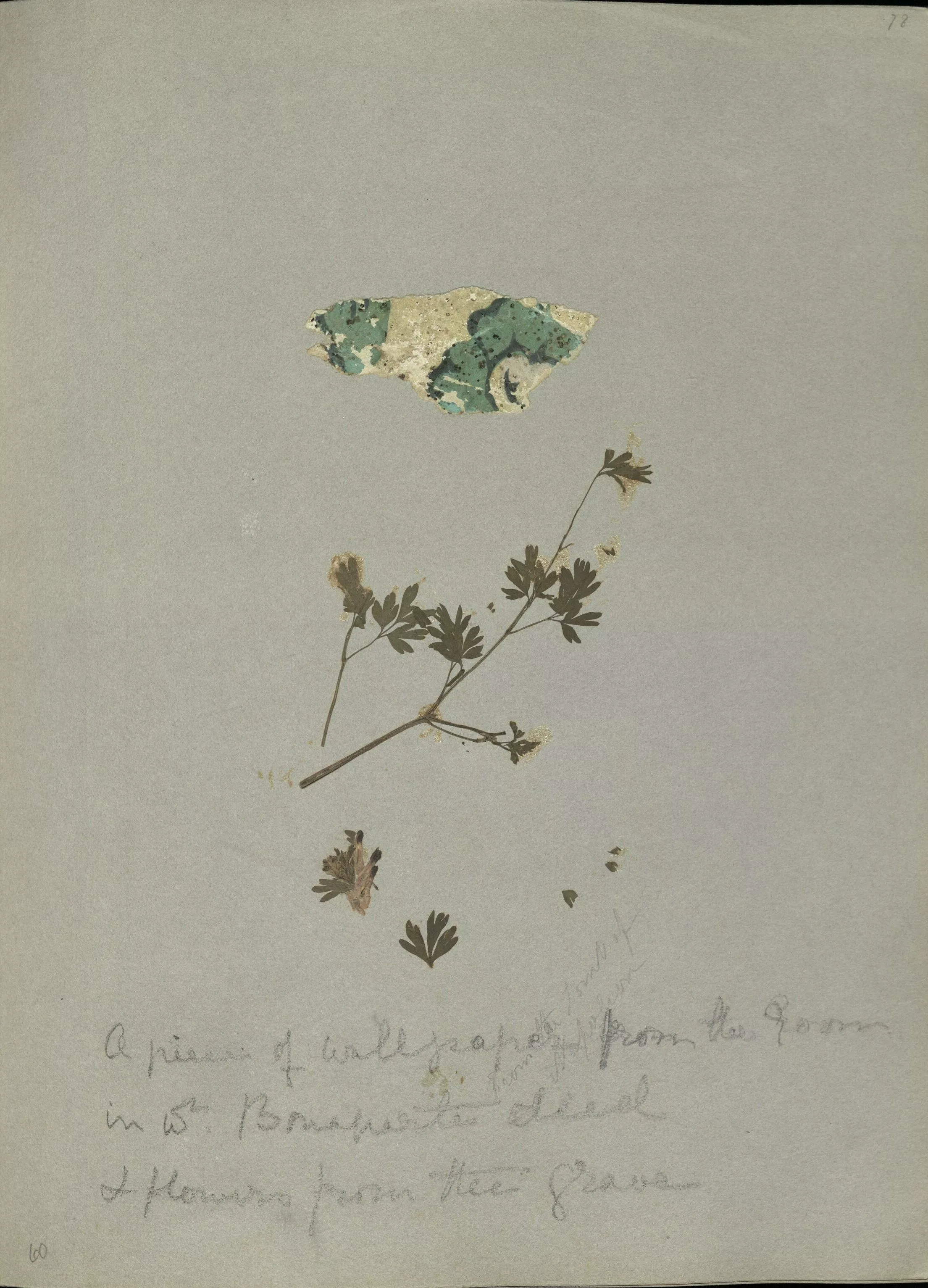Creation Date
After 1821
Medium
Genre
Description
Preserving dried flowers and a scrap of wallpaper, this page is found in the album that was kept over many years by the salonnière and painter Elizabeth (Eliza) Aders. The pasted-in piece of wallpaper seems discolored with age, and has an indistinguishable green and off-white pattern. The dried flowers pasted onto the page appear similarly battered by time and have begun to crumble away. One pencilled-in caption on this page reads “A piece of wallpaper from the room in wh[ich] Bonaparte died. & flowers from the grave.” Another pencil note, possibly in the same handwriting, intersects the first two lines of the caption: “from the tomb of Napoleon.”
Most of the material that fills up this red morocco leather album was contributed by the celebrated writers and painters who frequented the dinner parties and musical evenings that were hosted during the 1820s and 1830s by Aders and her third husband, the German merchant and art collector Karl (Charles) Aders. The album pages contain, among other contributions, verses by Goethe, Charles Lamb, and Mary Lamb among others, snippets of letters, pencil drawings by John Flaxman, Charles Landseer, and Jakob Götzenberger, and a watercolor by Richard Westall. On the first page there is a note addressed to Aders by Samuel Taylor Coleridge, who has followed it on the succeeding page with a version of his poem “The Two Founts,” here titled “To Eliza in Pain” and signed “S. T. Coleridge. 3 June 1826.” The particular page imaged here, however, lacks an identifying signature or date: Aders herself may have created it, but that is uncertain. It is likewise difficult to say how the relics that the page exhibits traveled to England from the South Atlantic island of Saint Helena, where Napoleon Bonaparte died in 1821. Those relics transplant part of that physical place into an Englishwoman’s book, at the same time that they memorialize that person.
Pressed flowers are frequently found on the pages of Romantic-era albums, book that were often bestowed as gifts on blooming young girls: that inclusion of floral matter was a conventional way to honor feminine youth and beauty and to gesture toward the fertility that feminine bloom was meant to promise. A botanical specimen that is pressed between the pages of a book and saved for readers of the future is immortalized at the peak of its beauty, but it has to die in order to be preserved. And it is a fragment of a larger whole even before, as on this page, time takes a toll and it begins to crumble into pieces. That entanglement of preservation with loss means that album pages featuring this kind of botanical souvenir often function as memento mori. Even as they memorialize feminine beauty, they also emphasize its transience. Aders was no longer a blooming girl in the year in which this album filled up, however (and by the year of Napoleon’s death, she had already been married three times and divorced twice), and in its contents her album is significantly less floral than many others assembled during her lifetime. This page represents an exception, however, which makes it all the more interesting that here the deaths of a few flowers have been made to stand in for the more consequential death of Napoleon. In combination with the scrap of wallpaper, these botanical souvenirs seem to claim a masculine, history-making figure for a feminized and domestic tradition.
Associated Persons
Associated Works
Collection
Accession Number
MS Eng 1094 Houghton Library
Additional Information
Original publication date: After 1821 (based on internal evidence). According to the Houghton Library catalog record, the Aders album was compiled between 1811 and 1874.
Place of creation (if known): Likely London; possibly Godesberg, Germany.
Provenance (if known): Purchased by the Houghton Library with the Amy Lowell Fund, 1958.

